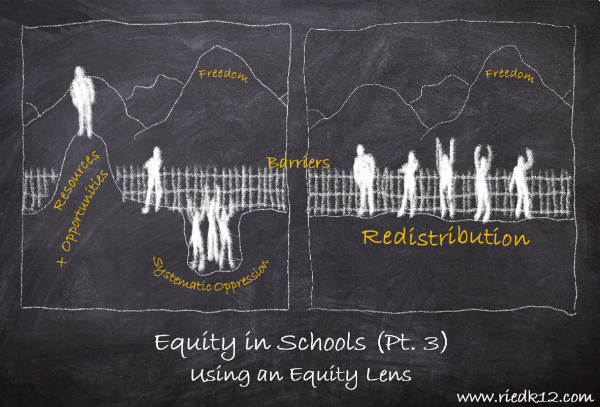Equity in Schools (Part 3): Using an Equity Lens
Check Out first: Equity in Schools (part 1), and Equity in Schools (part 2)
Understanding the definition of Equity in Schools (part 1), and recognizing the effects of counterproductive misunderstandings of equity (part 2) is useful, but merely understanding and recognizing equity or inequity does not necessarily lead to equity. Action leads to equity. Understanding is the parking lot; building one's social justice and racial equity lens the entrance ticket; using that lens to ask the right questions and take meaningful actions is the game. Questions like:
Does my curriculum lead to equity? For example, does my curriculum tell the truth, build critical consciousness and lead to changing opportunities and access to resources for those systematically denied access, or does my curriculum perpetuate the dominant narratives and inequitable outcomes?
Do my standards and outcomes for student growth and proficiency lead to equity? Or, do I have lower expectations for Native, Black, and Brown students and am therefore cutting them off from access to resources and opportunities later on in life?
Does my classroom or school’s discipline structure lead to equity? Or, does it criminalize Black and Brown scholars -- generationally denying said scholars access to resources and opportunities?
After asking these questions, and the hundreds of more questions that develop as a result - this work should lead to action. If your curriculum is not reinforcing equity - replace it (see our Re-Imagine Education lesson plans for ideas). If your students are not making enough growth or are not proficient -- find the tools and support needed to teach them. If your systems are not equitable or used in an equitable way -- change them.
An equity lens means constantly questioning your own actions and the systems you are a part of and then using that framework to take action and change systems.
Equity work is not done at a presentation once a year, once a semester, or even once a week. Racial equity needs to be woven into every action we take and thought we have in schools. When we do professional development on reading interventions - it should be through an equity lens. When we teach reading, or math, or science, or art, or P.E. - it should be through an equity lens. When we choose materials to highlight it should be through an equity lens. When we set goals and standards it should be through an equity lens. When we reflect on our practice - it should be through an equity lens… always asking the question - how did, does, or will this lead to a redistribution of resources and access to opportunities for people of color who have been systematically denied access for over 300 years.
An equity lens must be used to cipher through downright oppressive policies and rhetoric, but equally as important an equity lens is necessary to cut through the faux-equity that is actually closer to what Freire called complacent authority, which is so often embraced by teachers and administrators alike who are looking for a way to obscure their own collusion with deficit model thinking and lower-expectations that result in a lack of access for the very communities they ostensibly serve.
At a certain point, we need to stop superficially talking about equity and move to be about equity in everything we do. Once we have true equity, breaking down fences and finding liberation becomes within reach. Because equity is not the end game - though it is an important step on all of our paths to freedom.
Ian McLaughlin
